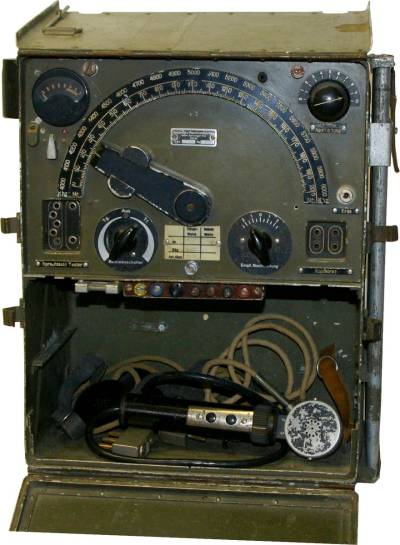Inhaltsverzeichnis
SE-108: K1-Gerät
Kleinfunkgerät der Artillerie K1 (Low Power Set of the Artillery K); developed and produced by Zellweger AG, Uster.
In the mit - thirties, Zellweger, Uster, developed a low power set to replace the slightly outdated TL-Station; the compact low power transceiver got the designation K1 and K1A.
The battery operated set K1 operates in the 4 - 6 MHz range, the similar K1A can be operated from batteries or a hand cranked generator and operates in the 22 - 28 MHz range.
Technical Data
- Frequency range: 4 - 6 MHz, lock positions every 10 kHz
- Output power: 1 W
Power supply
- Accumulator / Batteries: 2 heaters batteries 6V (9606), 2 plate batteries 60V (9660)
Dimensions
- 320 x 455 x 220 mm, 20,5 kg
The wireless set consists of the Apparatekasten (case with the transceiver and a battery compartment) and a Reservematerialkasten (20 kg; spares case).
Accessories
- Standard antenna is a whip antenna consisting of ten segments and a total length of 3,3 m, in addition to this two counterpoise wires of 5 m of length.
- In later years, a NG K1 K1A P P5 power supply was available to power the set without the need for batteries.
Operation
The K 1 set (Artillery set) consists of a transceiver case with a battery compartment (weight 20,5 kg) and a spares case (another 20 kg) with spare tubes and batteries.
The transceiver has to be powered from a 6V heaters / LT battery and two 60V anode / HT batteries, another two batteries of each type stored in the spares case will give an operation autonomy of around 80 hours.
 The operation of the transceiver is uncomplicated: The huge frequency dial pointer also acts as tuning knob, it does directly operate the main tuning capacitor of the transmitter and receiver sections. Press the two pushbuttons at both sides of the dial pointer to move it, it will lock in 10 kHz steps mechanically. A rotary control „Empfangsnachstellung“ permits to shift the receiver's operation frequency +/- 20 kHz.
The operation of the transceiver is uncomplicated: The huge frequency dial pointer also acts as tuning knob, it does directly operate the main tuning capacitor of the transmitter and receiver sections. Press the two pushbuttons at both sides of the dial pointer to move it, it will lock in 10 kHz steps mechanically. A rotary control „Empfangsnachstellung“ permits to shift the receiver's operation frequency +/- 20 kHz.
As found in other Zellweger sets, the main switch has it's zero / off position in the middle, turn it to the left for telegraphy mode and to the right for telephony mode, the control also acts as volume control. A ring switch at the microphone / headphones combination activates the transceiver.
Use the antenna tuning control to adjust for a maximum reading on the antenna current instrument when the transmit switch is activated; the meter can also be switched to indicate the heaters (blue/yellow) and anode / B+ voltages (red/black), too.
The accessories can be stored in a compartment just below the transceiver chassis: the LT and the two HT batteries, the headphones, the hand mike and the throat microphone.
The set's operation range is 5 km in telephony and 10 km in telegraphy mode under standard conditions and up to 20 or 40 km from a optimum location on top of a hill.
Technical Principle
 The set uses the valve types Tungsram KF3U and CB220U: On the transmitter side, in the oscillator stage (V1) a KF3U is used, in the amplifier and fimal amplifier stage (V2, V3) two CB220U) are used. In the modulator stage (V8), another CB220U is found.
The set uses the valve types Tungsram KF3U and CB220U: On the transmitter side, in the oscillator stage (V1) a KF3U is used, in the amplifier and fimal amplifier stage (V2, V3) two CB220U) are used. In the modulator stage (V8), another CB220U is found.
In the Receiver the signal from the antenna is mixed in the mixer stage (V4, KF3U) to generate the intermediate frequency, the IF is amplified in two stages (V5, V6: KF3U each) and demodulated in V7 (CB220U).
Valve layout
V1 (KF3U, Oscillator); V2 (CB220U, RF driver); V3 (CB220U, RF output stage); V4 (KF3U, Mixer); V5 (KF3U, 1. IF stage); V6 (KF3U, 2. IF stage); V7 (CB220U, Demodulation) and V8 (CB220U, Modulator).
Development
For use of the artillery units and as a replacement set for the TL, Zellweger developed the „K-Station“ with an operation distance of 5 km in telephony and 10 km in morse code telegraphy A1, which was introduced with the troops ins 1937/39.
The number of sets (143 units or according to the documentation „Funkstationen der Armee“ 133 sets for a price of 4'700.- Fr. each) was not sufficient for the needs of the artillery. Because of other services, which used the small frequency range and led to overcrowding of the frequencies, Zellweger developed the K1A, which used the 22 - 28 MHz frequency range.







